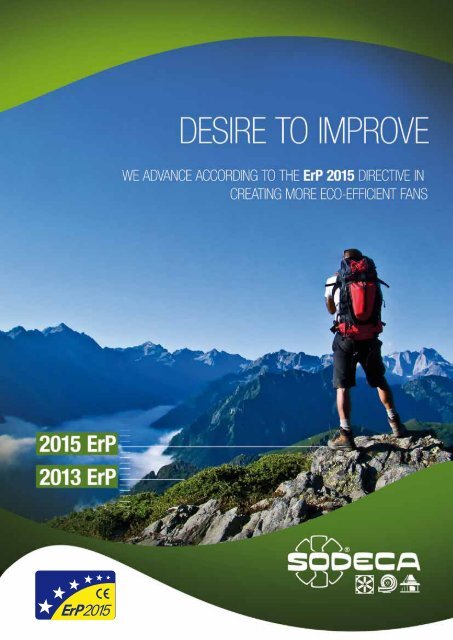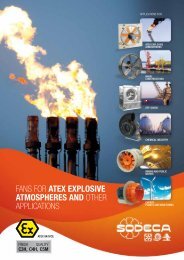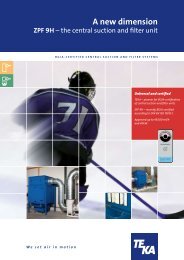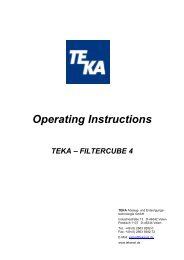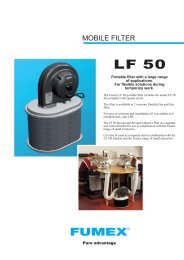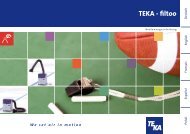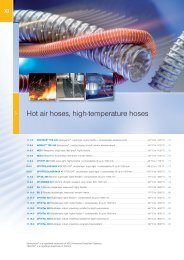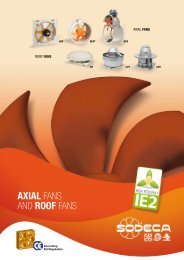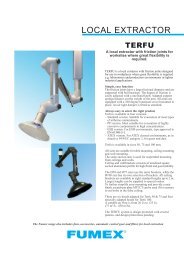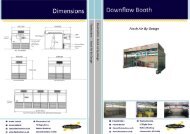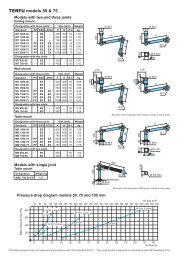ErP - Sodeca
ErP - Sodeca
ErP - Sodeca
- No tags were found...
Create successful ePaper yourself
Turn your PDF publications into a flip-book with our unique Google optimized e-Paper software.
<strong>ErP</strong> DIRECTIVEMORE ECO-EFFICIENT FANSWhat does the new “ERP”directive mean?The <strong>ErP</strong> Ecodesign directive 2009/2015/CE is going to encourage sustainableand economic use of the available energyresources. Its main goals are encouragingecological design and fighting againstclimate change by reducing CO2emissions to the atmosphere.In coming years, applying this directive willaffect all energy receptor and consumerproducts in a way that is respectful to theenvironment.• In effect until the year 2020, the EUis attempting to comply with theKYOTO treaty by increasing the use ofrenewable energies by 20% rather thanthose coming from minerals.• This can be achieved by controllingand improving the quality of theperformance of electronic devices withmore efficient new designs.For this reason, specific norms arebeing developed for each co-marketedproduct in the EU: Electric motors, waterpumps, fans for residential and industrialenvironments, transformers, etc... Andfor this goal, a series of studies is beingcarried out for the different categoriesof apparatuses ranked by LOT, fromwhich the first regulations are appearing,including those for fans.How is the <strong>ErP</strong> directive goingto affect fans?The first regulation from the (EU)Committee 327/2011 has already beenpublished, as a fruit of the study forthe “LOT 11” category, which is goingto regulate non-residential fans withabsorbed electric power between 125Wand 500 KW.The regulation establishes two phases forits complete implementation:• 1st phase: Starting in January 2013,the first level of requiring efficiency infans will be applied.• 2nd phase: Starting in January 2015 iswhen these levels of requirements willbe increased.These two phases are related with thosealready applied by the 2009/640/ECDirective on standard electric motors,which began last year in June 2011. Sincethen, <strong>Sodeca</strong> has been applying IE2efficient motors in all of its fans.In the second phase after January 2015,all electric motors used must comply withan IE3 efficiency. IE2+ Inverter motorsand EC motors will be utilize as the onlyalternatives.The efficiency of fans will be greatlyimproved through the use of moreefficient motors. Improvements will alsobe introduced through the use of moreappropriate configurations of turbinepropellers or through new, more optimaldesigns.After each phase, products not complyingwith the aforesaid requirement will notbe able to be marketed in the Europeanmarket.Are there exceptions on theaffected fans?Yes, at least with the corresponding fansincluded in the LOT11 category, andapart from products that are regulatedin the future by other categories thathave not yet been finalized. The current(EU) 327/2011 regulation in effectcorresponding to LOT11 containsexceptions, such as:• Fans for ATEX explosive atmospheres.• Fans exclusively for emergency use(400ºC/2h, 300ºC/1h, etc...)• Fans specifically for working inenvironments greater than 65ºC, or tobring gases to more than 100ºC.• Fans specifically for working inenvironments or temperatures of gasesbrought lower than -40ºC.• Fans with motors of special voltagesVac>1000V or Vcc>1500V.• Fans for toxic, highly corrosive orinflammable environments.• Fans used to transport non-gaseous(solid) substances, in industrialprocesses.There is also the possibility of marketingfans that do not comply with 327/2011,until January 1, 2015, if they are destined toreplace fans integrated in products marketedbefore January 1, 2013.2
And with products exported to other countries outside the EU?Compliance with this directive will only be required within the EU.Will the efficient fans be specially marked?Yes, CE labels will be prohibited on products that fail to comply with this directive. It should also be well specified which productscomply, both in the catalogs and selection programs that are utilize.Will these fans be more expensive?Many <strong>Sodeca</strong> fans already comply with the requirements of the directive. But in cases where acquisition is significantly higher, theenergy savings will make up for the investment. And as a result, they will be much more profitable over the long term. <strong>Sodeca</strong> isincorporating new, state of the art technologies with IE2, IE3 and EC system high efficiency motors, which will also provide otheradvantages of regulation, communication and interaction with other equipment.SOLUTIONS THAT SODECA OFFERS AS ALTERNATIVESTHAT ARE DETERMINED BY EACH CASE:Directly using three-phase, synchronizedIE2 and IE3 motors. Solution especiallyindicated for power greater than 1 CV(750W).The same IE2 synchronized motorscombined with marketed frequencyregulators in the installation of theequipment, or through compact systemswith the electronics already included in themotor or fan and assembled in the factory.This combination will facilitate adaptingto 50Hz or 60Hz networks, with differentvoltages and including single-phasenetworks if the equipment’s power allowsfor it.Or also through BRUSHLESS, permanentmagnet EC motors Motors that permitobtaining very high efficiencies with speedand constant pairing independent from thecharge. In comparison with normal inductionmotors, they can achieve equivalentpowers but with much greater efficiencyand reduced size. In this case, electronicsare incorporated and therefore control andregulation functions will be incorporated.3
How is the goal of efficiency calculated?The CE Regulation nº 327/2011 has assigned minimumrequirements of efficiency in two phases, the first is applicablein 2013 and the second, which is more strict, in 2015. The goalsof efficiency are determined according to the type of fan, theelectric power consumed in the point of maximum efficiency ofthe fan and the type of aerodynamic test used. The degree ofefficiency (N) is the value that the required efficiency provides forincoming electric power of 10 kW. N is different according to thetype of test used and increases when passing from the first to thesecond phase of application. For example, in axial fans testedwith C tests, the N value required for 2013 is 36% and for 2015 is40%, as shown in the following image.Goal (%) Goal for axial fans and measurements C-type42%Degree ofefficiency 2015,N=40Degree ofefficiency 2013,N=3640%38%36%34%32%30%28%26%24%22%201520130 2 4 6 8 10 12 14 16P e(d)(kW)IF THE FAN IS COMPLETELY SUPPLIEDa. If it does not havea speed driver:b. If it does havea speed driver:Where, for the optimum point of efficiency:• η eis the global efficiency.• P u(s)is the gas power of the fan.• P eis the incoming electric power for the motor supply.• P edis the incoming electric power for the speed driver supply.• C Cis the compensation factor of the partial charge.For P edgreater than 5 kW, it is 1.04. For powers less than 5 kW,the factor is greater. See the image attached.C c1,161,141,12How is the efficiency of the fan calculated?Fan performance is calculated at the point of maximum efficiency.This should be equal to or greater than the required goal. Thecalculation method is different according to the elements that thefan incorporates and whether or not it is in its final assembly.ElectricpowerP edHydraulicpowerP us1,11,081,061,041,020 0,75 1,5 2,25 3 3,75 4,5 5,25 6P ed(kW)LossesDriverLossesMotorLossesTransmissionLossesTurbine4
IF THE FAN IS SUPPLIED IN PIECES0,90,850,80,750,7Where, for the optimum point of efficiency:0,650,60,55• η eis the global efficiency.• η ris the turbine efficiency, according toWhere P u(s)is the gas power and P ais the mechanical powerto the axis of the turbine.• η mis the motor efficiency. Motors should be used that complywith the (CE) Regulation nº 640/2009 for motor efficiency.If the fan is supplied without a motor or the motor is not coveredby the regulation of motors, the performance can be estimatedaccording to the incoming electric power recommended (P e(kW))for the optimum point of energy efficiency of the fan. Thesevalues by default can be observed in the following image.• η Tis the efficiency of the transmission system. For fans withdirect transmission, it is equal to 1. The transmission isconsidered highly efficient when the belt width is equal to orgreater than triple its height. Timing belts and toothed gears arealso highly efficient. Its performance can be estimated throughthe power at the turbine axis (Pa (kW)). Pa values are consideredconstant that are less than 1 kW and greater than 5 kW. See theimage attached.• C mis the compensation factor to take into account to adapt tothe components. It is 0.9.• C Cis the compensation factor of the partial charge. If there is nospeed regulator, it is 1. If there is a driver, it has the same valuesas the fan in final assembly.0,50 1 2 3 4 5P e(kW)0,960,940,920,90,880,865 30 55 80 105 130 155P e(kW)Low efficiencyHigh efficiency10,980,960,940,920,90,880 1 2 3 4 5 6P a(kW)5
AXIAL FANSAND ROOF FANSCENTRIFUGAL FANSAND IN-LINE DUCT FANSFANS FOR THESMOKE EXTRACTIONFANS FOR ATEX EXPLOSIVEATMOSPHERES AND OTHERAPPLICATIONSNEW SERIES - NEW PRODUCTSNEW CATALOGUESNEW BUSINESS OPPORTUNITIESLOW-PRESSURECENTRIFUGAL FANSHEAT RECOVERY ANDFILTRATION UNITSAIR CURTAINS FORCOMMERCIAL ANDINDUSTRIAL APPLICATIONSVENTILATION SYSTEMSFOR HOUSES AND FLATSRequestInformationCrta. de Berga, km 0.7E-08580 St. Quirze de BesoraBARCELONA (Spain)Tel. +34 93 852 91 11Fax.+34 93 852 90 42comercial@sodeca.comExport sales: ventilation@sodeca.comwww.sodeca.com


